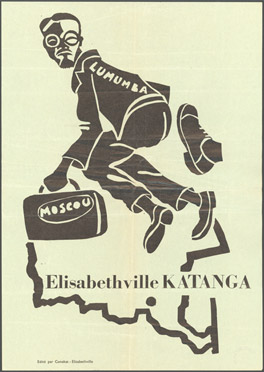THE CONGO CRISIS
 Katangan secessionColl. RMCA Katangan secessionColl. RMCA |
The mutiny of the Force Publique On 4 July 1960, Force Publique soldiers in Camp Leopold, in the capital, and Thysville sign a petition demanding the africanization of the Force Publique officer corps. The next day, they mutiny against Lumumba and the Force Publique's commander, General Janssens. The latter had declared: 'Après l'indépendance = avant l'indépendance' ('After independence = before independence'). Despite Lumumba's concessions, the mutiny spreads; rebellious soldiers soon turn against Belgian civilians, who leave the country in a mass exodus. After Belgian troops intervene, Lumumba and Kasavubu call for UN intervention and peacekeepers arrive to relieve Belgian troops. Secession: Katanga and South Kasai On 11 July 1960, Moïse Tshombe, president of CONAKAT, declares the secession of the industrial province of Katanga, supported by Belgium. On 8 August 1960, with the support of Western countries, Albert Kalonji of the MNC-Kalonji proclaims the establishment of the Autonomous State of South Kasai, where diamond mines are located. It is later renamed the Federal Kingdom of South Kasai. While the UN demands that Belgium withdraw its troops, it refrains from intervening in what it deems Congolese internal politics. The Congolese government therefore appeals to the Soviet Union, spreading the international impact of the crisis and leading to Lumumba's assassination. The assassination of Patrice Lumumba Lumumba makes enemies everywhere: as a unionist, he opposes Western powers (including Belgium), which prefer a confederal Congo with autonomous provinces in order to maintain control over the country's economic resources. Accused of being a communist, he is disowned by members of his own government and by the Katangan government. Joseph Kasavubu has only a formal role: at the national level, political power is held in reality by the group of Binza, a small, informal, unstructured group that opposes Lumumba and includes his former secretary Joseph-Désiré Mobutu, Mario Cardoso and Justin Bomboko; all three attended the 1960 Brussels Economic Round Table. Lumumba, 67 days after taking office, is dismissed by Kasavubu and placed under house arrest. He tries to escape but is captured by Mobutu's soldiers. Lumumba, Minister Maurice Mpolo and the Senate vice-president, Joseph Okito, are transferred first to Thysville, then to Tshombe. On 17 January 1961, the three men are assassinated in Elisabethville. To erase all traces, the bodies are dismembered, soaked in acid and burned. Lumumba's assassination provokes an international outcry: Belgium, in particular, is accused of being responsible. In 2001, a Belgian parliamentary commission concludes the Belgian government was morally responsible for Lumumba's assassination, and the government apologizes to the Congolese people and Lumumba's family. Rebellions In 1961, after a bloody military campaign during which thousands of civilians are massacred, the central government ends the secession of South Kasai. In 1963, the UN puts an end to Katangan secession. In 1964 and 1965, unionist forces lead a mass rebellion against the central government, killing 500,000 according to some historians. It begins in Kwilu under the leadership of Pierre Mulele, who was one of Lumumba's ministers. Other rebels, including Christopher Gbenye, General Olenga, Gaston Soumialot and the future president of the Democratic Republic of Congo Laurent-Désiré Kabila, launch the Simba Rebellion in the east and take Stanleyville. The End of the Simba Rebellion The rebels conquer three-quarters of the country. To put an end to the rebellion, Joseph Kasavubu appoints Moïse Tshombe prime minister. Supported by Katangan gendarmes in exile and Western mercenaries, the Armée Nationale Congolaise (ANC) advances on the Simba, who take Western hostages in Stanleyville. Tshombe appeals to the Belgian and American governments: Belgian paratroopers, supported by British and American troops, are deployed. They free most hostages and evacuate Europeans and Americans from Stanleyville. With mercenary support, government forces retake the city and end the rebellion. The 1965 elections Joseph Kasavubu remains president during the Congolese crisis. After the rebellions end, Moïse Tshombe forms a government of national reconciliation to reunite the Congolese and pacify the country. A new, federal constitution authorizes multipartyism and organizes the country into 21 'provincettes' corresponding to the former colonial districts. In 1965, Congo holds legislative elections. Only men can vote. After the elections, Joseph Kasavubu replaces Tshombe with Évariste Kimba. The next month, Colonel Mobutu overthrows the president and prime minister. |


